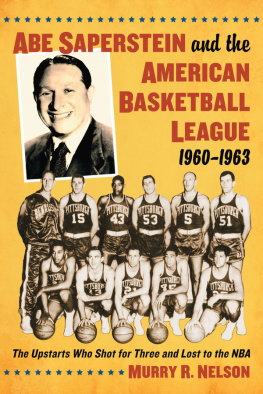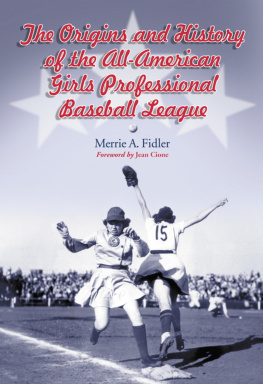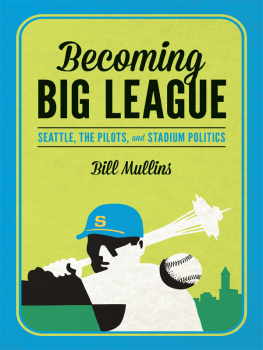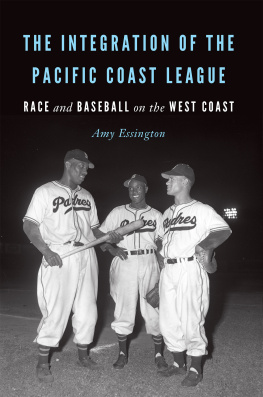
Abe Saperstein and the American Basketball League, 19601963
The Upstarts Who Shot for Three and Lost to the NBA
MURRY R. NELSON

McFarland & Company, Inc., Publishers Jefferson, North Carolina, and London
LIBRARY OF CONGRESS CATALOGUING DATA ARE AVAILABLE
BRITISH LIBRARY CATALOGUING DATA ARE AVAILABLE
e-ISBN: 978-1-4766-0128-1
2013 Murry R. Nelson. All rights reserved
No part of this book may be reproduced or transmitted in any form or by any means, electronic or mechanical, including photocopying or recording, or by any information storage and retrieval system, without permission in writing from the publisher.
On the cover: (top) Publicity photo of ABL Commissioner Abe Saperstein; (bottom) team photograph of the Pittsburgh Rens (both courtesy of the Dolph Briscoe Collection, University of Texas Archives)
McFarland & Company, Inc., Publishers
Box 611, Jefferson, North Carolina 28640
www.mcfarlandpub.com
To the players of the American Basketball League, too soon forgotten
Acknowledgments
This book started as a chapter in another volume, but thanks to Mike Domjan, an old college friend, I was able to access the necessary files on the American Basketball League at the Dolph Briscoe Center of the University of Texas Archives. That center contains the Abe Saperstein papers as part of the Joseph Anzivino Collection. I am indebted to the archivists there for their assistance in the acquisition of papers from the collection, as well as their permission to reproduce documents from the archive. The Saperstein Papers are well organized and indexed, allowing great access in person or through copies. My thanks to Vern Morrison and colleagues at Cleveland State University Libraries and Archives for the reproduction and use of photographs from the Cleveland Memory Collection.
Steve Ross was kind enough to do searches for legal cases, then provide them to me. He also read some of the chapters and provided useful feedback.
Carolyn Hastings was instrumental in the location of various players I was able to interview. She also provided the Cleveland Pipers audit material. Rich Macales also helped me locate players and other personnel to interview. Richs encouragement in reading early drafts of chapters was greatly appreciated. Jose Padilla offered encouragement and suggestions. Matt Zeyzing, Bill Tosheff, Charlie Rosen, Seymour Smith and Neil Isaacs were also helpful in this endeavor. The alumni office at Tennessee State University also deserves to be recognized for their help in providing player information.
Those interviewed were great helps, despite recalling events and people from 50 years before. I thank John Barnhill, Bill Sharman, Monte Moore, Roger Kaiser, Kenny Sears, Hal Lear, Sylvester Blye and Rossie Johnson, all of whom provided insights and anecdotes from the ABL.
The Interlibrary Loan staff at Pattee Library at Penn State University was helpful in obtaining newspapers as well as identifying papers that had been digitized and were available in that manner.
Jennifer Glasgow in the Department of Curriculum and Instruction at Penn States College of Education was a great help in her copying of materials, re-formatting of data and overall clerical assistance. Ken Noel did great photography.
I also thank the various members of the North American Society for the Study of Sport History for feedback on early drafts of chapters for this volume. The web site of the Association for Professional Basketball Research and specifically, Robert Bradley, was also of great help; I want to acknowledge that assistance.
Finally, but most valued, my wife, Elizabeth, has been a great help in providing feedback and allowing me to spout off, at times, on the process and problems associated with this book. Her love and support continue to amaze me.
Introduction: An American Basketball League Overview
When I told people with a modicum of knowledge regarding professional basketball history that I was writing a book on the American Basketball League (ABL), there were a number of reactions, most of which indicated that there was very little familiarity with the subject. Some people immediately thought that the book was on the American Basketball Association (ABA), the league that existed from 1967 to 1976 before agreeing to disband in the latter year, with four of their teams, San Antonio, Indiana, the New York Nets and Denver, becoming members of the NBA. No, that wasnt the league I meant.
Some thought that I might be referring to the American Basketball League that began in 1925 and folded in 1933, later to return as a regional league, which became the Eastern League. That league had as members the Original Celtics for two years, years in which they dominated the league and were forced to disband for the good of the league. No, not that league.
And there were those who were totally perplexed, having no idea whatsoever who or what the American Basketball League might be. These people far outnumbered those who actually were aware of the leagues brief existence, although even those folks were hard pressed to name a team or player in the ABL. And that is very sad, considering the effect that the ABL ultimately had on professional basketball and, later, by extension, on all of basketball, through the ABLs unique rules.
In the late 1950s Abe Saperstein may have been the most inuential, if not the most powerful, person in professional basketball. That inuence was a result of his ownership of the Harlem Globetrotters, the only consistently successful economic engine in professional basketball. No team could be assured of selling out a game (really a show/event) more than the Globetrotters. Such a realization had led to the NBA working with Saperstein through the 1950s in a cooperative arrangement that found the Globetrotters playing the opening games of many doubleheaders in which the second game was a clash of two NBA teams, most often in an NBA arena, but not always.
By the late 1950s the NBA had come to stand on its own two feet, but the league was now playing doubleheaders involving four NBA teams, and often playing NBA games in arenas other than those of the NBA. The league was still economically challenged; the draw of the Globetrotters was still greater than that of the NBA.
In August of 1960 Abe Saperstein and his partners formed the American Basketball League. Teams were drawn from the National Industrial Basketball League (NIBL), a semi-professional league, some independent professional teams and some that were formed for the new league season. The creation of the league was coincidental with the collapse of the NIBL, and a number of players were drawn from that league.
On March 18, 1961, the league announced ownership and franchise locations. There would be eight teams in two four-team divisions. The East would be the Washington Tapers, the Pittsburgh Rens, the Cleveland Pipers and the Chicago Majors. The West would consist of the Kansas City Steers, the Los Angeles Jets, the San Francisco Saints and the Hawaii Chiefs. The key locations would be where the ABL would compete directly with the NBAin L.A. and Chicago, where the NBA had located its rst expansion franchise since the formation of the league in 1949. The Tapers would be owned by Harry Lynn of Washington, D.C., and would be a continuance, to a degree, of the Tuck Tapers of the NIBL, sponsored by the Technical Tape Corporation. Paul Cohen, the president of Technical Tape, would be a director of the team. The Rens chose a name to honor the great New York Renaissance teams of the 1920s1940s and would be owned by Lenny Litman. The Pipers would be almost wholly formed from the Cleveland Pipers team of the NIBL and would be owned by George Steinbrenner and coached by John McClendon, longtime coach of Tennessee A&I and the rst African American coach of a major professional, integrated basketball league. The Chicago Majors were initially assigned to Morrie Schneer as owner. There were nancial problems, and Schneer dropped out almost immediately. The team ownership was swapped with the owner of the San Francisco Saints, Abe Saperstein, also the league commissioner, and George McKeon took over the San Francisco franchise. The Steers would be owned by Ken Krueger of St. Louis and coached by Jack McMahon, a former NBA player who had recently retired because of injuries. The Jets would be owned by Len Corbosiero and coached by Bill Sharman, late of the Celtics, who would also play a bit. The Hawaii franchise was owned by Art Kim. Kim had called his franchise the Hawaii Aliis, a name for Hawaiian royalty, but in June he informed the league that the name would be Chiefs. The reason Kim gave was that members of the Hawaiian royalty had informed him that it was taboo to use the name of Aliis in conjunction with ordinary people as it could only be associated with the ancient Hawaiian royalty.
Next page










